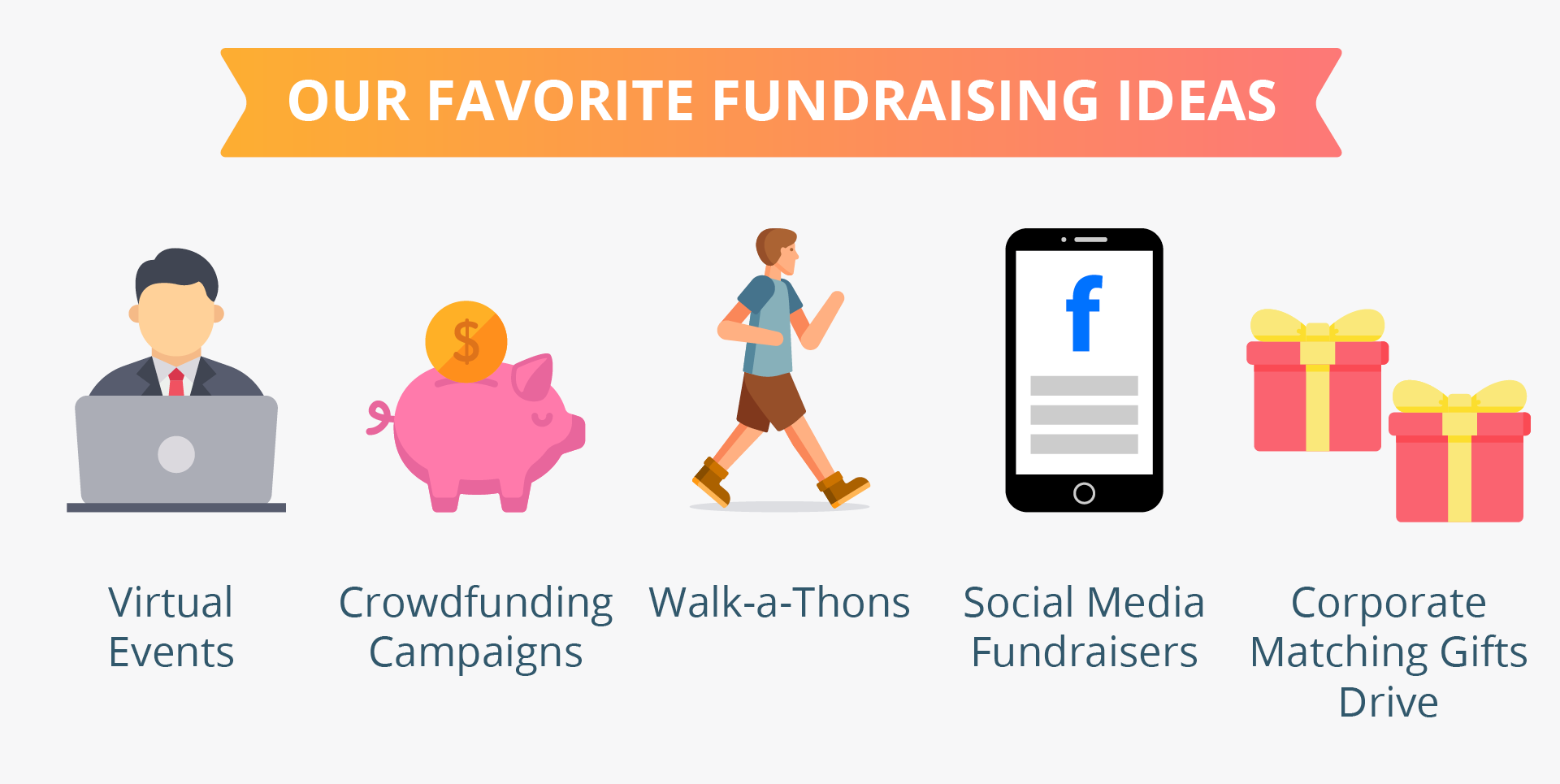Your community has a critical need, and you believe your nonprofit can meet it. But before you can expand your programs, you’ll need additional revenue.
Hosting a successful fundraiser requires more than just having a great idea—you’ll need to have the resources, software, and other tools to coordinate it. Here we list this year’s top five fundraising ideas and the tools you’ll need to implement them.

- Crowdfunding Campaigns
- Virtual Events
- Walk-a-Thons
- Social Media Fundraisers
- Corporate Matching Gifts Drive
Nonprofits can strengthen their relationships with donors using the communication, reporting, and general fundraising tools available from expert fundraising platforms such as NonProfitEasy. The fundraising favorites and relevant resources below will set your future endeavors up for success.
1. Crowdfunding Campaigns
Many nonprofits favor crowdfunding campaigns due to their simplicity, share-ability, and user-friendliness. While crowdfunding campaigns rarely attract major gifts, these fundraisers are a perfect solution for soliciting many smaller and midsize donations, which can add up very quickly!
Here’s how it works:
- You create a campaign page on a dedicated crowdfunding platform.
- Add important details about your fundraising needs, your mission, and how the revenue will be used.
- Share your fundraising page URL on your social media profiles, through email, on your website, and more.
- Encourage supporters to give to your campaign and to share the fundraiser with their own online networks.
- Update your campaign page throughout the fundraising process to keep supporters up-to-speed and to drive additional donations.
The best part about crowdfunding is that it’s an effective method for raising both money and awareness for your cause. Even supporters who are unable to contribute financially can get involved by taking an ambassador role and sharing your fundraising page with their networks.
What You’ll Need
The most important thing you need to launch a crowdfunding campaign is a dedicated site to host your fundraiser. This list of top crowdfunding websites walks through some of the most popular platforms to help you start your search for the right platform.
Thankfully, the majority of crowdfunding sites are free to get started with, meaning you’ll only pay a small percentage of what you raise through minimal processing and platform fees.
2. Virtual Events
Fundraising events are a staple of nonprofit engagement strategies. While these traditionally take place at a physical location, many organizations have begun adopting virtual events as well.
The good news is that nearly any fundraising event (including galas, auctions, trivia competitions, and more) can be transformed into an engaging virtual experience as long as you have the right tools.
Here’s how it works:
- Decide on the type of virtual event to host.
- Invite donors and other supporters to save-the-date.
- Build out and test your event software toolkit.
- Explain how attendees will participate in your virtual event (often through live-streams).
- Don’t forget to market your fundraiser for maximum success!
- Launch your event to raise money through ticket sales, additional donations, bidding revenue, and more.
Fundraising events allow nonprofits to raise significant amounts of money while providing attendees with an engaging and unforgettable experience. Virtual experiences take things a step further by opening your event up to be more accessible and convenient, so that more supporters can get involved.
What You’ll Need
To manage a virtual fundraising event, you’ll need an online event platform. If you already have event software for your traditional fundraising events, you can likely repurpose several of these features to help run your virtual fundraiser.
While the perfect solution will depend on the type of event you host, the most important features to look for include ticketing and registration, live-streaming, and payment processing.
3. Walk-a-Thons
Walk-a-thon fundraisers are fun and engaging pledge-style events that can deepen supporter relationships and introduce your nonprofit to new potential donors.
Here’s how it works:
- Gather a group of supporters who are willing to fundraise on your behalf by participating in your walk-a-thon. Determine how you will keep track of participants’ times and distance completed.
- Equip participants with a customizable online fundraising page and encourage them to incorporate personal photos and a summary of their connection to your organization.
- Empower supporters to share their online campaign page with their friends, family, and loved ones to request sponsorships. For most walk-a-thons, supporters will collect pledges based on how far they walked, but others accept flat donations as well.
- Host your walk-a-thon event.
- Report results to sponsors, who then collect the pledges they received.
If you want to put a twist on this traditional idea, consider hosting other types of event-a-thon fundraisers. Organizations have seen success with dance-a-thons, bike-a-thons, read-a-thons, and more—and they all follow the above basic format.
What You’ll Need
Walk-a-thons are a popular example of peer-to-peer fundraising, which means the amount raised is much higher using an online peer-to-peer giving platform. These platforms allow your volunteer fundraisers to create personalized campaign pages that collect funds for your mission to share with their friends and family .
4. Social Media Fundraisers
You already use social media to promote your nonprofit and spread the word about your cause. But are you also effectively using social media as a fundraising platform?
Here’s how it works:
- Publish content to your social media profiles explaining your fundraising needs and how supporters can participate.
- Set up your campaigns so that they target specific audiences and goals.
- Collect donations either through platforms’ built-in tools or direct social media users to external fundraising pages (such as your crowdfunding campaign!) to give.
Many nonprofits collect funding from social media fundraisers, but most don’t have a dedicated strategy in place to maximize that revenue stream, which can cause your campaign to struggle and leave potential dollars on the table.
As social media continues to grow and new platforms emerge, your nonprofit can make the most of this fundraising method and empower your followers to get involved.
What You’ll Need
As explained above, you’ll need an active presence on all social media platforms through which you plan to fundraise.
While many popular social networking sites now incorporate their own built-in fundraising tools (such as Facebook Fundraising and integrated donate buttons on Instagram and TikTok), others might require you to create an online fundraiser on a separate platform. In that case you can still fundraise through those channels by linking posts to an external campaign page.
5. Corporate Matching Gifts Drive
Thousands of businesses will match their employees’ donations to nonprofit causes dollar for dollar—yet many eligible donors are unaware of these programs.
When you incorporate matching gifts into your fundraising strategy, you can raise more money efficiently, improve your relationships with donors, and forge partnerships with charitable-minded businesses.
Here’s how it works:
- Build out a donor base.
- Inform donors about the power of corporate matching gifts by sharing educational resources on your website, via social media, and even through direct mail.
- Encourage donors to research whether their employers offer matching gifts programs and, if so, to request that their employer match their donation.
- Keep track of matching gift revenue collected from corporate matches and thank donors for both their initial gift and the match you received.
Many nonprofits favor matching gift campaigns because they essentially have double the impact. Donors appreciate matching gifts because they know their contribution can go farther without having to fund more out of their own wallets. It’s a win-win!
What You’ll Need
While it’s certainly possible to host a matching gift drive with minimal tools by requiring donors to conduct their own research with their employers, individuals are unlikely to take this additional step. That’s why we recommend investing in a matching gifts database and search tool.
Do some research to determine whether a searchable database tool is right for your organization. These databases can be embedded directly into your nonprofit website and donation forms so that eligible donors can find relevant information about their companies without ever leaving your site.
The right fundraising software can make a huge difference in your success, especially a powerful nonprofit CRM and donor management software to manage every aspect of your fundraisers and supporter relations effectively. Good luck!



